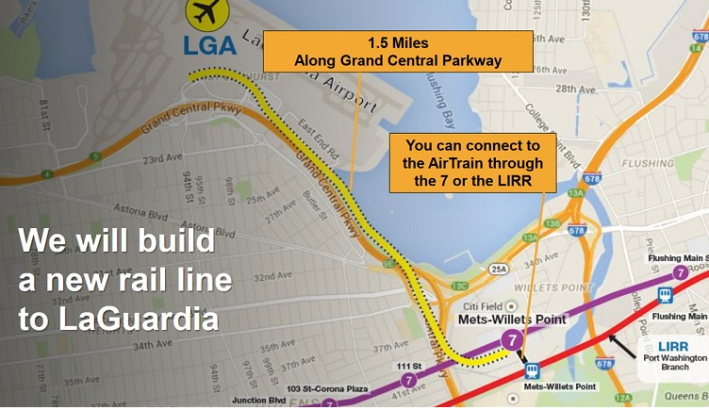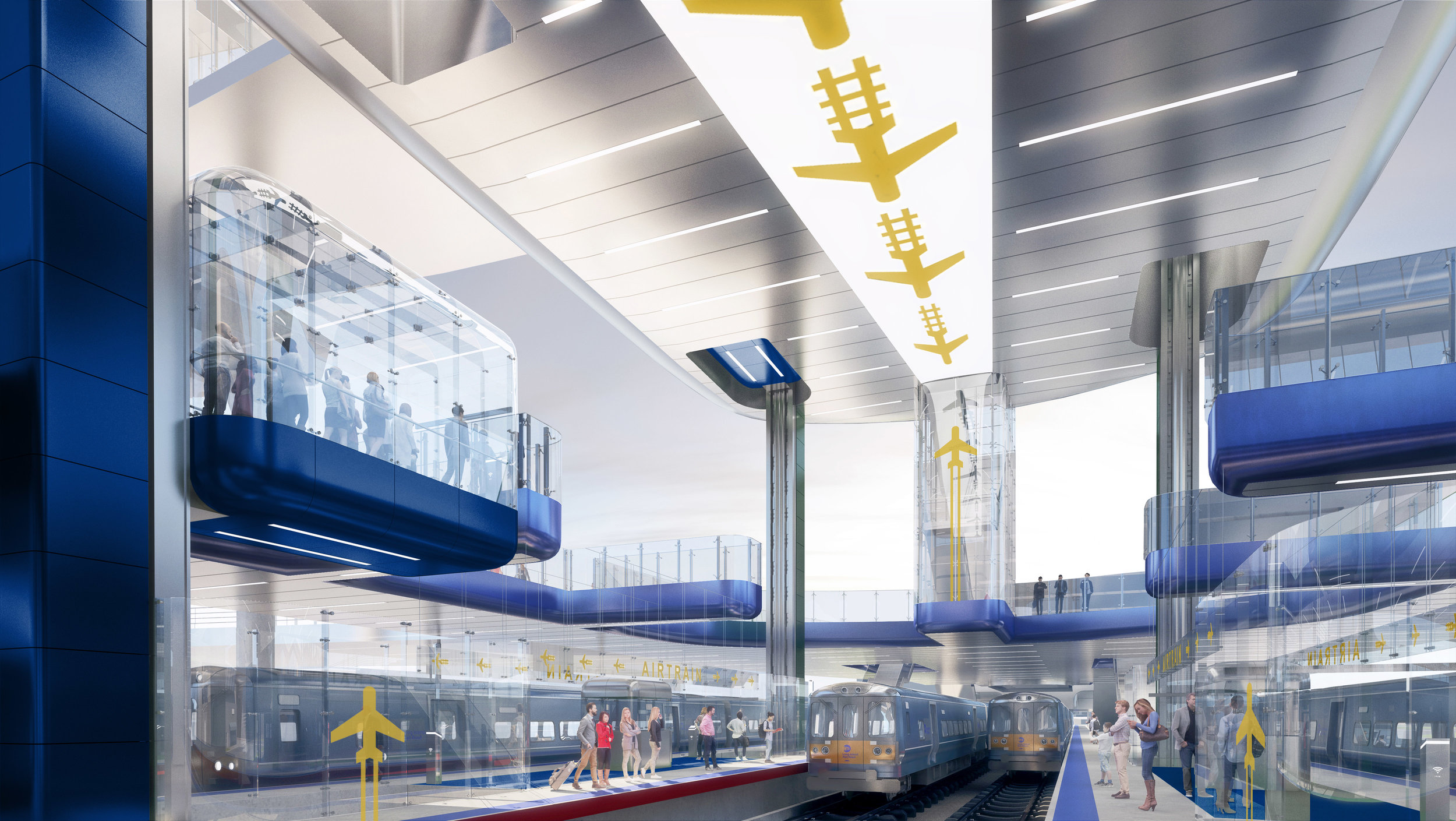As the LaGuardia AirTrain moves forward through a Federal Aviation Administration environmental review, many questions remain about the project’s costs, benefits and environmental impact.
The project would build an elevated railway from the airport running for 1.5 miles along the Grand Central Parkway and Flushing Bay east to Willets Point, where it would connect with the 7 subway and the Long Island Rail Road’s Port Washington Branch.
New York City residents should not have to rely on the distant FAA for the review of a project that would be built entirely in the city; they should demand that Gov. Cuomo and the Port Authority of New York and New Jersey address their concerns at local forums — such as hearings subjecting the project to City Environmental Quality Review and the Uniform Land Use Review Process. Only then can the AirTrain’s supporters justify its social costs and disruptions — and the money it will shower on consultants, labor unions and construction contractors among the governor’s big donors — as well as explain its purported benefits.
As a former federal official who oversaw transportation projects in New York and New Jersey for more than three decades, I see the following cost-related, operational, and environmental issues looming in this major construction project:
Ballooning construction costs/unrealistic completion timeline
The project’s history to date does not inspire confidence that it will come in even at its current $2.05 billion price tag — more than four times its 2014 cost estimate of $450 million.
Costs will be further refined as the project progresses through the environmental review, preliminary and final design, and the award of construction contracts, followed by change orders to the base contracts during construction, because of last-minute changes in scope or unforeseen site conditions.
The final cost for the AirTrain could end up being several hundred million to $1 billion more than that — especially because new plans propose to build over the Flushing Bay Promenade or Flushing Bay.
The original 2021 completion date promised by Cuomo will not happen. The revised 2024 completion date the governor now envisions also may suffer the same fate. Completion of the environmental review may not result in a Record of Decision by the FAA until late 2020 or early 2021. The next step would be preliminary and final design and engineering, which will require two more years. Next is advertising and award of a construction contract followed by contractor mobilization. Cuomo will be lucky if construction begins in 2024 and is completed by year-end 2027.
Potential construction disruptions
The FAA review eliminated a number of alternatives to the Port Authority’s proposed Willets Point AirTrain route because, it said, those alternatives would constitute too much of a disruption to communities or to transit.
Well, construction in and around Willets Point would open its own can of worms. It would probably require many weekend closures of the 7 train between 111th Street and Main Street, with a shuttle-bus operation in effect. The same might apply to service on the LIRR Port Washington branch.
As Queens residents know because of recent switch-replacement work, those closures are a horror show. Not only are they a huge inconvenience for Main Street customers, they’re also difficult to schedule because of Mets weekends, U.S. Open weekends, other Citi Field or Flushing Meadows Park events, and Lunar New Year, which together eliminate 15 to 20 weekends a year.
Unaccounted-for operating costs
Reinvent Albany pointed out in July 2019 testimony to the MTA Board that neither PANYNJ nor the MTA has ever disclosed the projected annual operating costs of the AirTrain along with more LIRR and NYCT service. No one has identified the funding sources to pay for all this extra service, which easily will run in the millions annually.
Are these funds included in the MTA LIRR operating budget in future years? The same is true for LIRR capital dollars that might be necessary for fleet expansion to support more Port Washington branch service. PANYNJ insists that “There are no taxpayer dollars going to the proposed AirTrain LGA.” Forever and always?
Unrealistic service projections
The Port Authority’s contention that the AirTrain will provide a frequent, 30-minute ride between Midtown and the airport is a myth. The math doesn’t add up.
The Port Authority says the AirTrain will take six minutes to run to and from LaGuardia to Willets Point. OK, but travelers should factor in a six-minute wait for it. Travel time on the Port Washington train from Mets-Willets Point to Penn Station is 17 minutes. OK, good, but factor in a six-minute wait for it, too. Even those assumptions are rosy in New York City.

The killer for the LIRR is frequency. Most Port Washington rush-hour trains bypass Willets Point. Adding this stop would result in longer trips for commuters traveling westbound, especially during the morning rush. The same would be true for those traveling eastbound to stops between Flushing Main Street and Port Washington, especially during the evening rush.
Service on this branch off-peak runs every 30 minutes. Trains usually bypass Willets Point unless there are events. It may not be possible to send the six trains in each direction during the morning and evening rush that it would take to support frequent service. There’s no room! Even with the completion of Positive Train Control (which supports density), there is limited capacity on the Port Washington Branch to add much new rush-hour service.
Our train tunnels and stations, put simply, are packed. Right now, Penn Station does not have the platform capacity to accommodate any more trains during rush hours.
And LIRR East Side Access — the subterranean LIRR station which will come online at Grand Central Terminal in 2022 — may not help. The Environmental Review for ESA never contemplated LGA AirTrain service on the Port Washington branch; the idea did not exist at the time. The estimated 24 trains per hour that will go through ESA were planned to support service on other LIRR branches. The East River train tunnels that support Penn Station and the future ESA will operate at full capacity for years to come; those already have tight head ways between trains during the morning and evening rushes.
The No. 7 subway, while frequent, never supported the Port Authority’s 30-minute claim. It is a minimum of 25 minutes to/from Midtown via express service, which only operates inbound morning and outbound evening; it’s 30 minutes on the local. Now factor in a wait for it, too.
Conflicting environmental imperatives
New York City is spending $200 million on a cleanup project to bring back wetlands on the shore and upgrade the sewer system for Flushing Bay. Much of this work will be performed on the same shoreline as the proposed AirTrain. How much of this environmental remediation work will have to be repeated because of AirTrain construction? Will this issue be dealt with in the FAA Environmental Impact Statement? Are the two projects compatible? Will taxpayers be stuck paying twice for the same work?
These and other questions and scenarios point to the need for a much more thorough vetting for this project than will be done by the FAA; New Yorkers should insist on it. When the real costs of the Willets Points route come to light, some of the alternatives may not seem so bad.
Larry Penner worked for 31 years for the United States Department of Transportation Federal Transit Administration Region 2 New York Office on capital projects and programs for the MTA, NYC Transit, Long Island Rail Road, Metro North Railroad, MTA Bus, New Jersey Transit and other local transit agencies.







